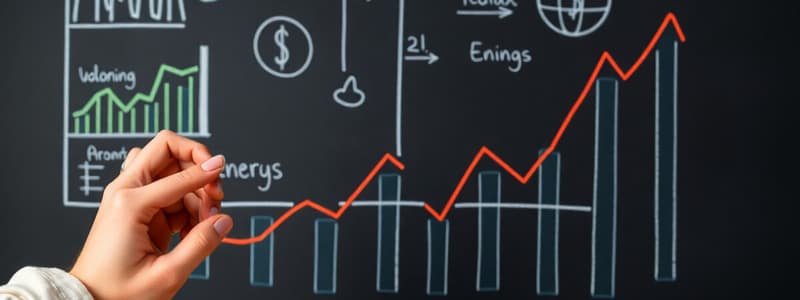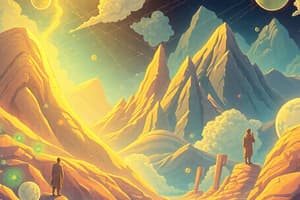Podcast
Questions and Answers
What does microeconomics primarily focus on?
What does microeconomics primarily focus on?
- Government economic interventions
- The analysis of inflation and unemployment rates
- Individual agents and specific markets (correct)
- The economy as a whole including national income
Which of the following best describes opportunity cost?
Which of the following best describes opportunity cost?
- The combined cost of production and supply
- The cost of the next best alternative foregone (correct)
- The benefit received from the chosen option
- The total cost of all alternatives considered
Which economic system relies on historical methods and traditions for decision-making?
Which economic system relies on historical methods and traditions for decision-making?
- Traditional Economy (correct)
- Mix Economy
- Market Economy
- Command Economy
What does the Production Possibility Frontier (PPF) illustrate?
What does the Production Possibility Frontier (PPF) illustrate?
Which economic theory advocates for government intervention to manage economic cycles?
Which economic theory advocates for government intervention to manage economic cycles?
Flashcards are hidden until you start studying
Study Notes
Definition
- Economics is the study of how individuals, businesses, and societies allocate scarce resources to satisfy unlimited wants.
Branches of Economics
-
Microeconomics
- Focuses on individual agents and markets.
- Studies supply and demand, consumer behavior, and production costs.
-
Macroeconomics
- Looks at the economy as a whole.
- Examines national income, unemployment rates, inflation, and economic growth.
Key Concepts
- Scarcity: Limited resources versus unlimited wants.
- Opportunity Cost: The cost of the next best alternative foregone when a choice is made.
- Supply and Demand: Fundamental model explaining how prices are determined in a market.
- Supply: Quantity of a good that producers are willing to sell at different prices.
- Demand: Quantity of a good that consumers are willing to buy at different prices.
- Market Equilibrium: Where supply equals demand, determining the market price.
Economic Systems
-
Traditional Economy
- Relies on customs and traditions.
- Economic decisions are based on historical methods.
-
Command Economy
- Central authority makes economic decisions.
- Often associated with government control.
-
Market Economy
- Decisions are made based on supply and demand.
- Prices are determined in free markets.
-
Mixed Economy
- Combines elements of market and command economies.
- Government and private sector coexist.
Economic Indicators
- Gross Domestic Product (GDP): Measures the total value of goods and services produced in a country.
- Unemployment Rate: Percentage of the labor force that is jobless.
- Inflation Rate: Rate at which the general level of prices for goods and services rises.
Common Economic Theories
- Classical Economics: Focus on free markets, competition, and the belief that markets are self-regulating.
- Keynesian Economics: Advocates for government intervention to manage economic cycles.
- Monetarism: Emphasizes the role of governments in controlling the amount of money in circulation.
Important Models
- Circular Flow Model: Illustrates how money and goods circulate in an economy.
- Production Possibility Frontier (PPF): Shows the maximum feasible amounts of two goods that can be produced with available resources.
Policy Tools
- Fiscal Policy: Government spending and tax policies used to influence economic conditions.
- Monetary Policy: Central bank actions that manage the money supply and interest rates.
Economic Challenges
- Economic inequality
- Inflation and deflation
- Unemployment
- Economic recessions and recoveries
Definition
- Economics analyzes the allocation of limited resources among competing wants of individuals, businesses, and societies.
Branches of Economics
- Microeconomics: Examines individual agents and market dynamics; emphasizes principles like supply and demand, consumer behavior, and production costs.
- Macroeconomics: Studies the aggregate behavior of the economy; focuses on national income, unemployment rates, economic growth, and inflation trends.
Key Concepts
- Scarcity: The gap between limited resources and infinite desires of consumers.
- Opportunity Cost: The value of the next best alternative that is forgone when making a choice.
- Supply and Demand: Central economic model determining price; supply refers to the amount producers will sell at varying prices, while demand is the amount consumers will purchase at those prices.
- Market Equilibrium: The point at which supply equals demand, establishing the market price for goods.
Economic Systems
- Traditional Economy: Economic decisions are shaped by customs and historical practices.
- Command Economy: Central authority, often the government, dictates economic decisions and resource allocations.
- Market Economy: Based on free market principles where decisions arise from the interplay of supply and demand.
- Mixed Economy: Integrates aspects of both market and command economies, with both government influence and private sector operations.
Economic Indicators
- Gross Domestic Product (GDP): Reflects the total value of all goods and services produced within a nation over a given time frame.
- Unemployment Rate: Measures the percentage of the labor force that is actively seeking but unable to find employment.
- Inflation Rate: Indicates the pace at which the general price level of goods and services increases over time.
Common Economic Theories
- Classical Economics: Advocates for minimal government interference in the market; posits that free markets lead to efficient outcomes.
- Keynesian Economics: Suggests active government intervention is necessary to smooth out economic cycles and stabilize the economy.
- Monetarism: Stresses the importance of controlling the money supply to regulate economic activity and maintain price stability.
Important Models
- Circular Flow Model: Demonstrates the flow of money and goods between consumers and businesses in an economy.
- Production Possibility Frontier (PPF): Graphically represents the maximum potential production capacities of two goods, illustrating trade-offs.
Policy Tools
- Fiscal Policy: Involves government spending and taxation strategies aimed at influencing economic performance.
- Monetary Policy: Consists of central bank strategies that manage the money supply and set interest rates to control inflation and stabilize the economy.
Economic Challenges
- Persistent economic inequality between different socio-economic groups.
- Fluctuations between inflationary periods and deflationary pressures.
- High levels of unemployment affecting labor markets.
- Economic recessions leading to downturns, contrasted by periods of recovery.
Studying That Suits You
Use AI to generate personalized quizzes and flashcards to suit your learning preferences.




